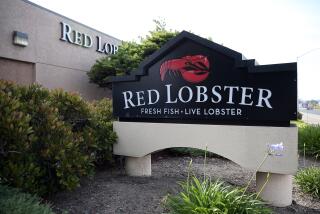Court Confirms Plan to Reorganize Greyhound : * Bankruptcy: Creditors will get 95% of the firm. But the door is still open for big future payments to striking drivers.
DALLAS — A U.S. bankruptcy judge late Friday confirmed the reorganization of Greyhound Lines Inc. but left open the prospect of potentially large future payments to its striking drivers.
Under the plan, creditors will get 95% of the company, with the remaining 5% going to employees, company spokesman Bill Kula said.
The decision by U.S. Bankruptcy Court Judge Richard Schmidt in Corpus Christi, Tex., to give his blessing after listening to two days of legal arguments, ends Greyhound’s Chapter 11 case that began in June, 1990, three months after its 6,300 drivers went on strike over wages and benefits.
“We’re feeling elated to say the least,” said Frank Schmieder, Greyhound’s president and chief executive. “It’s great for our employees.”
When Greyhound emerges from bankruptcy in late September or early October, it will be a company with publicly traded stock largely owned by its creditors.
The company’s restructuring was hindered by a back-pay claim made by the National Labor Relations Board on behalf of the striking drivers. The NLRB has asked an administrative law judge to set the size of the claim at $142 million.
That proceeding will take months to conclude, however, and could stretch for years with appeals.
To expedite the bankruptcy, Schmidt estimated the claim to be $31.25 million. He declined to rule what Greyhound would have to do to pay an amount above $31.25 million.
“I think the reorganized Greyhound still has a very big cloud hanging over its head,” said Peter Shinevar, attorney for the Amalgamated Transit Union, which represents the striking drivers and opposed confirmation of the company’s restructuring.
The union will likely appeal the confirmation, but Shinevar said it was too early to specify the issues it would cite.
Greyhound’s debts totaled $384 million at the end of March, 1990, most of which was the legacy of investor Fred G. Currey’s 1987 leveraged buyout that took the company private.
Debts rose to $631 million by the time Greyhound sought bankruptcy protection.
At the end of 1990, the company had assets of $488.8 million and liabilities of $654 million.
With completion of the reorganization, Greyhound’s bankruptcy plan projects year-end 1991 assets of $478.1 million and liabilities of $415.5 million.
“The only thing (the plan) doesn’t do . . . (is) it doesn’t settle the strike,” Schmidt said.
Schmidt said he believes that the union and company will settle the claim before the administrative court is forced to rule.
“We should encourage settlement,” he said.
Greyhound now has 3,600 drivers, about 700 of them former strikers, and offers a much reduced schedule compared to its prestrike operations, Kula said.
Greyhound’s largest creditors--soon to be its largest shareholders--are CEDE & Co., with a claim of $194 million, Security Pacific Equipment Leasing Inc., $53 million, and Citicorp, $31.5 million.
More to Read
Inside the business of entertainment
The Wide Shot brings you news, analysis and insights on everything from streaming wars to production — and what it all means for the future.
You may occasionally receive promotional content from the Los Angeles Times.










